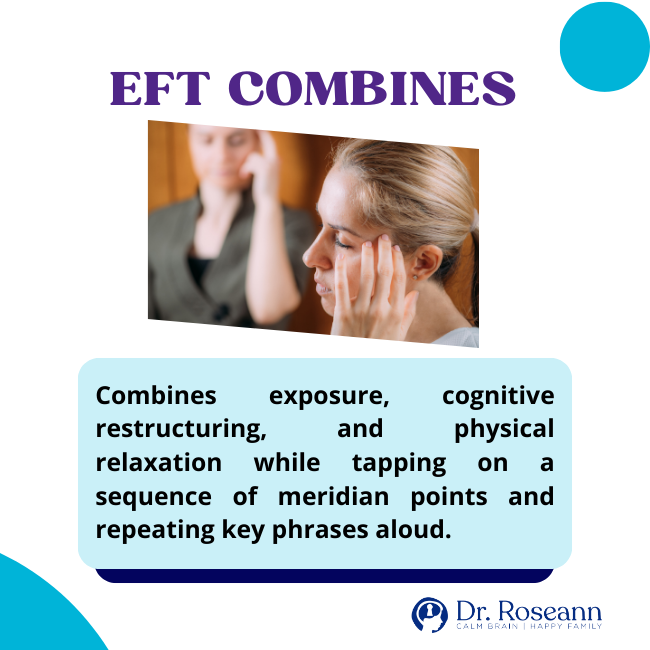Often when clients come in for therapy, many of their presenting issues are rooted in past negative events or traumas. We all experience traumas – big and small; and some people experience many traumas. Emotional Freedom Technique, or EFT (often known as Tapping Therapy or EFT Therapy), is a tool used by psychotherapists to help client manage stress and anxiety, as well as release negative emotions and past traumas.
What is Tapping Therapy Called?
Although most people refer to the non-clinical term “tapping,” therapists focus on the term “Emotional Freedom Technique” because the research and technique have a precise meaning. EFT is a tool used for physical, emotional and performance issues. EFT operates on the premise that no matter what part of your life needs improvement, unresolved issues are in the way. Any kind of emotional stress can impede the human body’s ability to heal itself. EFT works like emotional acupressure to quickly, gently, and easily release negative emotions and beliefs that are at the root of the problem.
What does the Research Say About EFT Tapping Therapy?
According to The Association for the Advancement of Meridian Energy Techniques (AAMET), many scientific studies have validated the effectiveness of EFT and continue to shed light on the mechanisms that underlie the process. The meta-analyses of research for anxiety (Clond, 2016) and depression (Nelms & Castel, 2016) demonstrate how effective EFT Tapping is in symptom relief.
The American Psychological Association (APA) validated EFT as an evidence-based treatment in 2012 (Feinstein, 2009). Additionally, numerous studies examine the treatment outcomes of EFT on individuals with post-traumatic stress disorder (PTSD), anxiety, depression, pain, physical performance, and weight loss. It is a growing area of scientific interest, and many studies are being conducted now.We are learning more about how EFT works and know that it impacts energy fields, improves neuroplasticity, changes cortisol levels, impacts the limbic system, and changes one’s brain waves.
We are learning more about how EFT works and know that it impacts energy fields, improves neuroplasticity, changes cortisol levels, impacts the limbic system, and changes one’s brain waves.

Researchers know that stressful and traumatic events can generate chronic and persistent arousal due to the innate flight or fight response. Chronic stress states make people more vulnerable to stress and negatively impact every part of the brain and body, impacting people emotionally and causing attachment issues.
How Does EFT Tapping Therapy Work?
As a form of psychological acupressure, EFT focuses on the same energy meridians that traditional acupuncture has used to treat physical and emotional ailments for over five thousand years.
Simple tapping with the fingertips inputs kinetic energy onto specific body meridians while you give voice to your specific problem. The technique combines exposure, cognitive restructuring, and physical relaxation while tapping on a sequence of meridian points and repeating key phrases aloud.

Fingertips contain points where the three main energy channels (Central, Right Main, and Left Main Channels) meet. Meridian points can be mapped throughout the body, where the energy circulates through your body along this specific network of channels.
You can tap into this energy at any point along the system, but EFT uses specific points to help release emotional and physical trauma. Due to its ability to reduce emotional stress, EFT can also help regulate blood pressure.This physical EFT tapping with the fingertips targets the acupuncture points on the face, such as the top of the head, nose, upper lip, or any body part where the energy is stuck to help clear this out. The physical tapping is how EFT works to help balance and open the way for the energy traveling through these channels to flow freely throughout the body.
How is EFT Tapping a Therapeutic Technique?
Not only is EFT a self-help tool, but when done under the care of a licensed psychotherapist, it is a therapeutic technique. As a self-help tool, one can learn EFT to manage stress and promote wellness. When done in a therapy session with a licensed psychotherapist, EFT helps address clinical issues.
In a psychotherapy session, faulty beliefs and cognitions are identified and addressed through the EFT process. With the assistance of a psychotherapist, one is able to work through conscious and subconscious issues in a way that supports the release of stress and unforgettable feelings.
What is an EFT Session Like?
An EFT session isn’t like a typical talk psychotherapy session. With EFT, one tap on specific body acupuncture points or tapping points while following a “Set Up Statement” that acts like a script.
First, you identify the issues or emotions you want to accent. Then, you give your emotions an intensity rating using a scale of 0 to 10. Upon completion, you will rate the intensity again to measure your progress.
EFT requires focusing on a negative emotion at hand, such as fear or anxiety, a bad memory, or an unresolved problem. Simultaneously, you mentally focus on this issue and use your fingertips to tap three to five times each on nine of the body’s meridian points. Integrating physical and mental awareness creates an adaptive systemic effect helping you identify patterns in your responses to stressors.
With EFT, you tap along a series of specific meridians while making statements to address faulty beliefs and cognitions, stress, or other uncomfortable feelings. You can tap on one side of the body or both, and the effect will be the same.
The first “tap” occurs on the side of the hand (this is called the karate chop). While you acknowledge the problem, you also need to acknowledge something reaffirming. For example, “Even though I feel anxious, I deeply and completely accept and love myself.”
You repeat the tapping sequence until you get the intensity rating down to a level where you feel comfortable. By tapping on these meridian points while concentrating on accepting and resolving the negative emotion, you access your body’s energy and restore it to a comfortable, more balanced state.
I recently used the EFT approach with a client who feared going to sleep at night. This client was afraid each night that she would be unable to sleep. Just thinking about attempting to sleep while sitting in my office increased the fear's intensity to a 9 out of 10.
We began tapping on the statement: ‘Even though I fear that I won’t be able to sleep at night and it’s a 9, I deeply and completely love and accept myself. After a few rounds of tapping, the fear came down to a 3.
With the intensity of the fear lower, we uncovered additional issues around the fear of not falling asleep. After just two sessions, the woman can relax into her nighttime routine and report better sleep.
How Does EFT Tapping Therapy Clear Emotions?
EFT focuses attention inward to bring awareness to an emotion or problem. The tapping restores wellness by releasing a stuck emotional experience or memory because the person can review the experience or emotion without reliving the experience and overactivation the nervous system.

Emotions are the primary link to the subconscious and lead us to the energy block’s location. During the tapping process, information arises from our subconscious mind to our conscious awareness because we create space for those emotions to release without reliving them by tapping to release stuck emotions, people clear energy blocks.
For some, these emotions create difficult-to-release physical issues, but EFT can release emotional and physical expressions of trauma and negative emotions. EFT training was first introduced by Gary Craig in 1995.
The “set-up statement” in EFT allows the emotion to simply be, without resistance or negative self-feelings, which is very different than talk therapy. This statement of self-acceptance and the “tuning in” that occurs when giving the problem an intensity rating helps people connect to the present moment without being over-activated.
EFT brings attention to thought processes that contribute to stress and emotional problems. Under these conditions, the emotion can be safely felt and expressed because you are compartmentalizing your emotions while simultaneously calming the nervous system through tapping on meridians.
Any internal conflict activated is supported by the tapping that coincides with the energy disruption helping to restore the balanced energy flow and internal peace by releasing the stuck emotion.
To learn more about conditions EFT treats, read this blog
Parent Action Steps
☐ Educate yourself about EFT tapping therapy to understand its benefits
☐ Locate a certified EFT tapping practitioner in your area or online
☐ Initiate a conversation with your child about EFT tapping therapy
☐ Engage in EFT tapping sessions with your child
☐ Establish a regular tapping routine with them
☐ Pay attention to changes in your child's emotional state, behavior, or stress levels
☐ Encourage your child to express their emotions during tapping sessions
☐ Be patient with your child and yourself
☐ Encourage your child to practice self-tapping whenever they feel stressed
☐ Keep an open mind about the potential benefits of EFT tapping therapy
☐ Download the 147 Therapist-Endorsed Self-Regulation Strategies for Children
☐ Take our Solutions Matcher to get personalized solutions for your child
Clond, M. (2016). Emotional Freedom Techniques for Anxiety. The Journal of Nervous and Mental Disease, 204(5), 388–395. https://doi.org/10.1097/nmd.0000000000000483
Feinstein, D. (2009). Controversies in Energy Psychology. Energy Psychology Journal, 1(1), 45–56. https://doi.org/10.9769/epj.2009.1.1.df
Nelms, J. A., & Castel, L. (2016). A Systematic Review and Meta-Analysis of Randomized and Nonrandomized Trials of Clinical Emotional Freedom Techniques (EFT) for the Treatment of Depression. EXPLORE, 12(6), 416–426. https://doi.org/10.1016/j.explore.2016.08.001
Always remember… “Calm Brain, Happy Family™”
Disclaimer: This article is not intended to give health advice and it is recommended to consult with a physician before beginning any new wellness regime. *The effectiveness of diagnosis and treatment vary by patient and condition. Dr. Roseann Capanna-Hodge, LLC does not guarantee certain results.
Are you looking for SOLUTIONS for your struggling child or teen?
Dr. Roseann and her team are all about science-backed solutions, so you are in the right place!
Discover 3 Natural Solutions for ADHD, Anxiety, and Mood
Empower yourself with natural solutions for your child's mental health and behavior. Download our FREE quick start guide and start supporting your child today.
You can get her books for parents and professionals, including: It’s Gonna Be OK™: Proven Ways to Improve Your Child’s Mental Health, Teletherapy Toolkit™ and Brain Under Attack: A Resource For Parents and Caregivers of Children With PANS, PANDAS, and Autoimmune Encephalopathy.
If you are a business or organization that needs proactive guidance to support employee mental health or an organization looking for a brand representative, check out Dr. Roseann’s professional speaking page to see how we can work together.
Dr. Roseann is a Children’s Mental Health Expert and Therapist who has been featured in/on hundreds of media outlets including, CBS, NBC, FOX News, PIX11 NYC, The New York Times, The Washington Post, Business Insider, USA Today, CNET, Marth Stewart, and PARENTS. FORBES called her, “A thought leader in children’s mental health.”

She is the founder and director of The Global Institute of Children’s Mental Health and Dr. Roseann Capanna-Hodge, LLC. Dr. Roseann is a Board Certified Neurofeedback (BCN) Practitioner, a Board Member of the Northeast Region Biofeedback Society (NRBS), Certified Integrative Mental Health Professional (CIMHP) and an Amen Clinic Certified Brain Health Coach. She is also a member of The International Lyme Disease and Associated Disease Society (ILADS), The American Psychological Association (APA), Anxiety and Depression Association of America (ADAA) National Association of School Psychologists (NASP), International OCD Foundation (IOCDF) International Society for Neurofeedback and Research (ISNR) and The Association of Applied Psychophysiology and Biofeedback (AAPB).
© Roseann-Capanna-Hodge, LLC 2023










